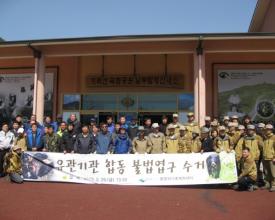
El oso asiático es una especie que se encuentra en la cima de la cadena alimentaria de los animales salvajes de Corea. Desde que se confirmó su existencia en 2000, se hizo importante mantener la raza de la población original reforzando los individuos de la especie. El proyecto de restauración del oso negro asiático pretende restaurar todo un ecosistema estableciendo una base en la que puedan coexistir humanos y animales salvajes. En 2001, el Instituto Nacional de Investigación Medioambiental seleccionó 4 osos jóvenes en cautividad y los liberó en la naturaleza en Jirisan a modo de prueba. La KNPS recibió osos negros asiáticos del Instituto Nacional de Investigación Medioambiental y estableció el Equipo de Gestión del Oso Negro Asiático en su oficina de Jirisan Sur en 2002. En 2004, seis ejemplares de la subespecie Ursus thibetanus ussuricus fueron importados de Rusia y liberados en Jirisan tras un periodo de formación para su adaptación. En 2005, cuatro parejas de la misma subespecie fueron enviadas por el zoo de Pyongyang Jungang y liberadas de la misma manera.
Contexto
Défis à relever
Ubicación
Impactos
- En 2018 se introdujeron en el hábitat un total de 47 osos procedentes de fuentes nacionales y extranjeras. 39 de estos animales fueron liberados.
- Dos hembras de oso negro asiático liberadas en la primavera de 2009 tuvieron una camada cada una. Desde entonces, las osas han parido en libertad todos los años.
- Aunque ha habido 3 generaciones de partos naturales de osos en libertad y el número de animales ha ido aumentando, solo unos pocos machos que ejercen el dominio en la región han participado en el proceso de cría. Por ello, han nacido oseznos de los mismos padres, lo que lleva a analizar que la diversidad genética está disminuyendo. Para resolver este problema, se ha sugerido que debe practicarse la inseminación artificial selectiva para asegurar múltiples individuos sanos en un acervo genético más amplio.
- Por ello, desde 2015 se están utilizando los datos obtenidos mediante la colaboración con instituciones de investigación extranjeras de EE.UU., Alemania y otros países para desarrollar tecnologías de proliferación artificial optimizadas para los osos negros asiáticos.
- 4 hembras fueron inseminadas artificialmente en julio de 2017, y 2 de ellas dieron a luz a 1 osezno.
- Desde que los osos fueron liberados por primera vez en 2014, ahora hay 69 viviendo en varias partes de la montaña Jirisan a partir de 2019. Si se mantiene la tendencia actual, se espera que aumente el número de ejemplares y se amplíe el hábitat.




